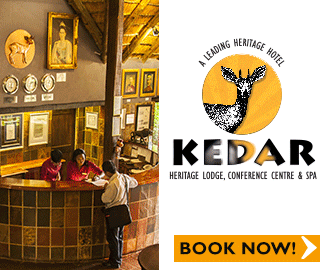

Daughters of the Moon
BY ALESSANDRO PARODI | 18 JUNE 2017 18:32
Ancient wisdom, mystical spirits, visions and dreams, complimented by natural forces, bones and herbs are the weapons of a sangoma, traditional healer of Southern Africa. In the city of Johannesburg, skyscrapers and shining towers make shadow over an ancestral religious practice. The sleeping forefathers of humankind thrive inside human passions and possess their priests in a violent entanglement that allows the healers to cure and bless their patients.
When the ancestors awake inside her, she will vigorously shake and loudly growl in a powerful and mysterious scream. The presence of the ancestors will take over her body, clearly announcing their arrival. Out of confusion and fear, she will consult the Elders and find out that she has a gift.
An ancestral calling. She will become a letwasana, a student of traditional medicine, and she will graduate as a sangoma after six months of rigid training under the supervision of a gobela (an experienced mentor and teacher). Through her training, the letwasana will learn the code of conduct of a healer, the use and meaning of beads, the function of herbs and medicines, the so-called muthi. At the end of the training, the initiate will undergo an intense ‘graduation’ ritual called intwaso.
This is how Mama Maria, a woman from the Pedi people born in the city of Phalaborwa, at the doorsteps of South Africa’s Kruger National Park, describes with dread and respect the ceremony of intwaso: “I am a Christian and I don’t support witchcraft,” she says, “but these spirits are real and I’ve seen my sister go through the sangoma initiation. They make you sick and you have to answer their call. During the ritual, she had to sacrifice a goat and drink its blood. It was scary and painful.”
We are in Johannesburg, a modern metropolis and the epicentre of Africa’s business. Downtown, in the shadow of the buildings of the stock exchange, banks, transport companies and international enterprises, hundreds of vendors crowd dusty streets trafficked by taxis and carts carrying recyclable rubble. Next to the taxi rank of Bree Street, the busiest in the city, a small shop sells herbs, animal bones and skins. Inside, you can find tools, rods, drums and clothes for the use of traditional healers and witchdoctors. In the neighbouring suburb of Marshalltown, the Mai Mai market hosts hundreds of stalls under an off-ramp of the M2 highway. Every stall sells muthi, raw and unprocessed herbs, animal body parts and potions of any kind used by the sangoma. A patient can use muthi (literally meaning ‘herb, medicine’) to receive the ancestors’ help in treating a disease of the body or of the mind, in enticing a lost lover, in killing an enemy or in gaining immunity during a robbery.
Muthi is the traditional alternative to western medicine and for centuries, the sangoma practitioners held the primacy over healthcare and religion. Today, the profession of a sangoma is regarded by modern citizens as evil and barbaric, thus forcing the healers and their clients into secrecy and social stigma. What’s more, some corrupted sangoma ‘witchdoctors’ employ their knowledge to serve evil purposes and are said to use poisons and human body parts in their rituals, resulting in hundreds of muthi-murders every year.
However, ‘good’ traditional healers distance themselves and their alleged ancestral power from evil practices and swear to protect their clients in natural and effective ways. They use the active principles of herbs to provide healthy treatments and demonstrate a profound affinity and respect towards the nature of Southern Africa. Today, thousands of them offer to the people of South Africa modernised – however unofficial – healthcare and psychological aid. Furthermore, many of them are women and they represent a crucial denomination of female power in a gender segregated society.
Driving from Johannesburg to Soweto – a township of 3 million people on the South-West outskirt of the city – is a journey into a different world. Surrounded by hills made of mining dumps, the township was built during the apartheid race-based regime to contain the black population of the Gauteng Province. The landscape of Soweto is made of small townhouses with asbestos roofs and tin shacks, making it look like a humungous yet pleasant town in the core of Africa’s powerhouse.
Soweto is said to be the dwelling place of the most powerful healers in Gauteng. One of them is Gogo Mpilo (born Neo Mangwana), a high-tech sangoma with a profession as Public Relations Practitioner and Change Management Manager. We meet her in a hair salon, while she is dying her dreadlocks.

Kids playing at the Mai Mai traditional market. Mai Mai is the equivalent of a traditional clinic. Sangomas operate here and you can find any kind of 'muthi'. Photo: Alessandro Parodi

Mama Shabalala is a wise sangoma. Her clinic is inside the Mai Mai traditional market. Photo: Alessandro Parodi
"I am a Christian and I don’t support witchcraft, but these spirits are real and I’ve seen my sister go through the sangoma initiation. They make you sick and you have to answer their call. During the ritual, she had to sacrifice a goat and drink its blood. It was scary
and painful.”
“I’m dying my hair red,” she explains, “because I miss having ledumani (red coloured soil that is applied on a Sangoma’s hair),”. Gogo Mpilo explains that she got permission from her ancestors to washout ledumani from her hair. She only applies ledumani, when attending a ceremony. “Ledumani colour red brings me closer to my ancestors.” Red is the colour of the African soil and symbolises the human roots in the ground. “Even when you go through the intwaso initiation, you have to apply ledumani on your hair.”
In her childhood and youth, Neo was often sick and doctors could not diagnose the source of her illnesses. This is a common treat to every sangoma and is considered to be a sign of the ancestors claiming the person for themselves. “I knew at a tender age that I had been called to be sangoma,” she explains, “and my family did a ceremony to plead with the ancestors to give me more time as I was too young. As I grew up, I chose to ignore the agreement my family had with the ancestors.
I did not want anything to do with the ancestral calling because I thought the calling would limit my personal dreams. The ancestors started losing patience with me and finally I answered my Ancestral Calling.” Now Neo operates under the sangoma name Gogo Mpilo ka Mndeni (‘the one who brings life to the families’). She explains that her gift is to bring restoration, peace and happiness to people.
When we get to her house, Gogo Mpilo describes the ceremony of her initiation and graduation and proudly shows her sangoma clothes, explaining the meaning of various prints on her garments. The shield of the swati tribe defends the healer from evil spirits; her ishoba, a bushy tail of a blue wildebeest that only sangoma graduates can use; a drum made of elephant paws she uses during various ceremonies; bones she uses for consultation (uku bhula); as well as the imphepho (helichrysum petiolare) incense used to communicate with the ancestors.
Gogo Mpilo kneels on the floor and claps her hands to inform the ancestors of the visitors. She starts the process by greeting and saying the totems of her ancestors. We can hear the words “thokozani Bogogo na bo Mkhulu” (‘I’m grateful’) and the rhythmic clapping of hands. Now we have the ancestors’ permission to enter her indomba (a sangoma’s consulting room). It is a neat room equipped with the latest technologies. There is a bath tub, where the patients can get cleansed and in a cupboard there are numerous jars filled with muthi. One is used to gain respect, another is said to solve conflicts, a third one is used for protection.
Gogo Mpilo, as well as many other sangoma healers, is a modern and successful woman with an extreme affinity to her people’s traditions and to nature. “Looking at the moon,” she says, “you can understand a lot about people’s life. When it is upside down, it is holding something, and as it turns throughout its phases it spills what’s inside causing a lot of changes,” Other natural elements she relates to are the veld (the South African prairie), where the evil spirits get lost, and water bodies, where the ancestors dwell and rest. Gogo Mpilo represents female wisdom and sensibility, and in her practice as a sangoma she embodies the centre of township life.
South African spiritual beliefs are a complex patchwork of ancient traditions and new-age trends. The South African population, which is split in tens of ethnic groups, is highly Christianised but also retains deep ties to an old system of values, where ancestral spirits, natural powers and customary laws are sovereign. In a vortex of different habits, rituals, prayers, dances and chants, miracles and prophecies, a genuine sangoma idles at the back of the South African religious carousel and claps her hands for peace and healing.
















